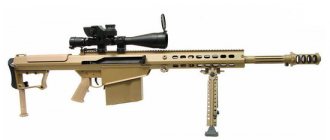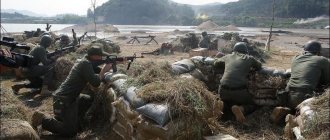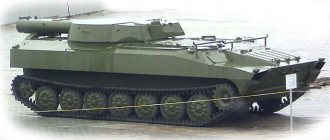Krupp guns
The company does not knit brooms... History
It is I who introduce inventions and create new industries, not the worker. He must be satisfied with his salary, and whether I make a profit or incur a loss is my own business...
Alfred Krupp
In 1865, for services to the fatherland, Wilhelm I - then not yet the German emperor, but the Prussian king - invited Alfred Krupp to accept the title of nobility. “This does not correspond to my desires,” he answered proudly. - I am Krupp! And that's enough".
Krupp! This name and the history of the emergence of the German Empire are inseparable. Krupp armor and Krupp guns, Krupp steel and Krupp rails - they helped unite Germany. They secured victory over Denmark, Austria and France. During the First World War, Krupp factories produced 10% of Germany's military products! They made no less a contribution to equipping Hitler's Wehrmacht. After both world wars, the victors thought that they had defeated not only Germany, but also the Krupp empire. And each time the “capital” of the Krupps - Essen - came to life again after some time. Numerous factory chimneys began to smoke again. And even if this concern now produces only peaceful products, who knows what awaits us in the future? The post-war years are not the first break in the militaristic activities of the famous concern. And, by the way, not the longest. Because there was a time when the Krupps were exclusively engaged in selling groceries for almost two hundred years.
And the beginning of the Krupps’ wealth was marked by... the end of the world! In 1599, a plague epidemic began in the city of Essen. There were mountains of corpses in the streets. Plague detachments, tapping with mallets, collected a rich tribute to death. Wandering preachers called the people to repentance, and the inhabitants of Essen fled from the plague-ridden territory to hell. Shops, houses, plots of land - everything that could not be taken with them - was sold for next to nothing. And only the poor moneylender Arndt Krupp did not lose his head. The real estate being sold ended up in his hands. Perhaps Arndt was also afraid of the end of the world, but he reasoned quite practically: if he had to die, he would die a rich man, and if he didn’t have to, he would live a rich man. And so it happened. The plague bypassed the cunning man. And everything that the first Krupp managed to buy formed the basis of the future wealth of his family.
Arndt's son, Anton Krupp, managed to increase his inherited fortune. In 1618, a war broke out in Germany - it would later be called the Thirty Years' War. Anton turned to the most promising market in this situation - the arms market - and regularly supplied the warring parties with muskets, pikes and other means of killing their own kind. The businessman's income turned out to be so great that already in the middle of the century the Krupps headed the business elite of Essen. The descendants of the nosy “realtor” Arndt and the “merchant of death” Anton invested money in a small hardware factory and several coal mines, bought land and lived quite comfortably until the beginning of the 19th century.
At that time, the affairs of the Krupps were led by Friedrich, the father of the first “great Krupp” and the “king of guns” Alfred. The romantic (by German standards) and dreamy Essen businessman decided to take a risk. Revealing the secret of English steel opened the way to high society and promised wealth and the personal patronage of Napoleon.
Friedrich Krupp House
At first, Frederick relied on espionage. The agents he hired scurried all over Europe. In terms of scope, this attempt at industrial espionage left the pitiful attempts of its predecessors far behind. Gossip, rumors - everything flocked to Essen. And finally - good luck! Two fugitive English officers agreed to give Krupp the “secret formula” in exchange for a tidy sum. Frederick rejoiced! He invested everything he had in the production of English alloy steel. In the suburbs of Essen, a new plant was being built at an accelerated pace... The ending of this story is logical. The British simply deceived the gullible Krupp. The “secret” formula turned out to be copied from a school chemistry textbook.
Then Frederick took up the matter himself, no longer trusting anyone. What is invented by one person may well be repeated by another, he reasoned. And in 1811, Krupp Gusstahlfabrik produced the first batch of high-grade steel.
However, Krupp crucible steel was still inferior in quality to English. This failure crippled Frederick. He retired from business, started drinking, and began to write poor poetry. To pay off his debts, the failed steel magnate sold everything, including the family mansion. In the end, Friedrich Krupp died of a broken heart, leaving as an inheritance to his widow and fourteen-year-old son Alfred a factory where only seven people worked, 10 thousand thalers in debt and a shed with a small vegetable garden where the family of a failed rich man huddled.
What the dreamer Friedrich failed to do, his son, the pragmatist Alfred, did.
Alfred Krupp
Having lost his fleet in the Battle of Trafalgar, Napoleon, in the fight against England, relied on the destruction of the merchant fleet and a continental blockade. He figured that if he stopped all trade with the British, the island state would fall at his feet like a ripe apple. However, it quickly became clear that Europe was much more dependent on Foggy Albion than it was on Europe. One of the problems was obtaining high-quality steel. The British guarded the process of its production as sacredly as the Chinese guarded the secret of porcelain and silk. Napoleon promised mountains of gold to the one who would reveal the secret and pull the nose of the arrogant Britons.
The process of producing high-grade steel was based on crucible melting, which was known back in the Bronze Age. Steel, charcoal and cast iron were placed in a fire clay vessel and melted in a coke oven at a temperature of 1700 degrees. The resulting ingots were indispensable in the production of weapons and machine parts. Until the 18th century, the ancient recipe was forgotten, and only in 1749 was it reinvented by Benjamin Huntman, a British watchmaker and metallurgist.
The year was 1926. For the sake of the family business, the teenager had to quit school and abandon plans to become an apprentice at the Düsseldorf Mint. Together with his brothers Hermann and Friedrich, he plunged headlong into business. The general management of the business was taken over by the widow of the unlucky seeker of the secret of steel. Theresa Krupp kept production in her hands until 1848.
From 1828 to 1834, thanks to the conclusion of a number of customs unions, the German states became a single economic space. The culmination of this process was the signing of the Prussian-German Customs Union. The disappearance of internal borders, duties and other restrictions contributed to the rapid rise of industry and its entry into the international arena. This is how political processes contributed to economic development.
In an attempt to uncover the secret of steel, the brothers, together with the factory workers, conducted many experiments and experiments. At the same time, Herman fought off the attacks of greedy creditors, and Alfred rushed all over Germany in search of clients and customers. In 1830 the first success came. The quality of steel has been noticeably improved. Two years later, a serious list of customers was selected. The Krupp factory began producing rollers for mints, leather working tools, files and much more. The Krupps provided a quality guarantee for all their products. A year later, the plant, which already employed ten people, began producing the first rolling mills. The acquisition of a steam engine made it possible to further expand production. Soon the Krupps had their first foreign clients.
In 1836, the Krupps began supplying their products to Brazil, in 1837 - to India, in 1838 - to Russia.
And in 1839 Alfred Krupp visited England. The official reason for the visit was to expand trade relations and get acquainted with advanced English methods of organizing production. In fact, Alfred went to the “workshop of the world,” as Foggy Albion was then called, with slightly different thoughts. He hoped to personally spy on the secret of English steel, which was still superior in quality to the products of his factory.
He never found out the secret, but he brought the idea of rollers for the production of spoons and forks. Having patented an improved version of the machine, he founded the Berndorf Metal Products Factory, which mass-produced silver cutlery. True, a little later, for the sake of economy, they began to stamp them from alpaca. Soon the Berndorf plant became the personal fiefdom of Hermann Krupp. But it took seven years for it to start making a profit.
Production expanded steadily, but by the end of the 30s, the threat of collapse once again loomed over the owners. The reason for this was... the quality of the products was too high.
We have all dealt with cupronickel silver tableware. Alpaca, or German silver, is the same cupronickel, but in addition to copper and nickel it contains zinc. Cupronickel silver was first used in China. In Europe, alpaca cutlery became known at the end of the 18th century.
Over time, metal production at the Krupp factory has undergone a number of changes. Moreover, this was largely due to the activities of one of the brothers, Friedrich. He managed to improve the quality of crucibles and reduce the layer of loose casting. The apparatus he invented for collecting dust generated during rough grinding was subsequently used in many other factories in Germany. Unfortunately, the future life of the youngest of the three brothers was unsuccessful. He left the factory and tried to become an inventor. However, things did not go well. Then Friedrich became a collector. He died in 1853 in Bonn, unknown to anyone and forgotten by everyone.
However, while carefully controlling the quality of their products, the Krupps fell into the trap of their own scrupulousness: the products they produced almost never broke, and the rolled products were surprisingly durable. There was no need for customers to purchase new products - and the company's sales began to fall. In 1847, the company's losses amounted to 21,139 thalers (about 200 thousand modern dollars). Alfred didn't even have enough money to pay his workers.
The Krupps were saved by the onset of the railway boom. The massive construction of railways that unfolded all over the world raised the demand for cast steel to the skies. At the factory in Essen they reacted immediately to the new situation. A wide production of axles, springs and rims was immediately established.
The pinnacle of activity in this direction was the invention of a seamless railway wheel, the stylized image of which became the emblem of the company for many years.
Logo
By the way, the concern’s famous trademark – “three rings” – also has an absolutely peaceful origin. This is not a pyramid of cannonballs at all, but just three railway wheels lying on top of each other. The emblem originated after Alfred Krupp created a seamless railway wheel in 1853-1854. It made its inventor rich. And the guns came later.
Even the crisis of the mid-50s, which affected many metallurgical enterprises in Europe, did not dampen Krupp’s new rise. The reason for it was the emergence of a new method of steel smelting - the Bessemer method. Developed by English metallurgist Henry Bessemer, this process produced large quantities of cheap steel. Enterprises that worked using the old crucible method went bankrupt one after another. But the far-sighted Alfred entered into an agreement with Bessemer in 1857 and received the right to use his method in his production. Now Krupp has also begun to produce rails. Soon, on both sides of the Atlantic - and what, all over the world - Krupp's seamless wheels were clattering on Krupp rails.
His acquaintance with Alexander von Humboldt played a significant role in promoting Krupp’s products to European markets. The young industrialist made a good impression on the 76-year-old naturalist, and Humboldt allowed Krupp to use his Parisian acquaintances to his advantage. For Alfred, then still completely unknown to anyone, this was truly a royal favor. The name of the great von Humboldt opened any door.
At the London World Exhibition of 1851 at the Crystal Palace, steel produced at the Krupp plant received the highest praise. Friedrich Krupp's dream came true, at least in part. Proud Britons recognized the superiority of Krupp metal! However, few people paid attention to the six-pound steel cannon, hidden among the samples of the Essen plant's products. But in vain. This small cannon marked a new stage in the activities of Alfred Krupp. The “Steel King” turned into a “Cannon King”.
At first, weapons production was nothing more than a hobby for Krupp. From the age of 23, in his rare leisure hours, he tried to cast a rifle barrel by hand. This not the simplest undertaking succeeded only seven years later - in 1843. And four years later, the Essen factory began producing blanks for gun barrels and other weapons components. The production of weapons has always brought good profits. In 1850, Krupp began to carry out individual orders. It was since then that a gun with a barrel marked with three interlocking rings became the cherished dream of any hunter for many years.
And in 1847, the first steel cannon barrel was cast in the workshops of the Essen plant. The tests of the new product passed, as they say, “with a bang,” but the military, contrary to the prevailing opinion about them, did not pay any attention to the new expensive toy. They trusted more in time-tested bronze. Steel, the metallurgists in their uniforms reasoned, is too close to iron, and iron is too brittle, and therefore neither one nor the other is suitable for making cannon barrels.
Small orders from third world countries did not cover development costs. Conquering the arms market turned out to be far from easy. At the Paris World Exhibition of 1855, it was not Krupp’s gunsmiths, but Solingen’s gunsmiths who received the gold medal. In 1859, Alfred wrote to his representative in Paris: “Although I show some interest in the question of the production of guns, I must say that I have long been fascinated by the idea of stopping the production of weapons. This production in itself is not very profitable, especially if you do it the way I did. Often the samples I produced did not go beyond the prototypes, which was both unprofitable and uninteresting for me, since it interfered with the fulfillment of other orders.”
Only in April 1860 did Prussia risk ordering 312 muzzle-loading steel guns. The breech-loading cannon developed in 1857 did not inspire optimism with its unreliable breech.
The result exceeded all expectations! During the Danish-Prussian War of 1864, the steel cannons of the Prussians showed their complete superiority over the bronze Danish artillery.
"Gussstahlfabrik" in 1864
Bessemer “liquid steel” was much cheaper and easier to manufacture than crucible steel. Suffice it to say that the entire production cycle took just under half an hour. The crucible process lasted almost a day. Naturally, when Krupp received orders for large quantities of cannon barrels, he tried to use Bessemer steel for their manufacture. However, the cheap metal turned out to be too fragile for this. The Essen plant was bombarded with complaints, and Krupp almost lost his hard-won fame.
After this triumph, orders poured in like from a cornucopia. Soon Alfred began supplying all European countries with artillery except France. The Austro-Prussian War of 1866 was the first military engagement in which both sides used Krupp artillery. So the reason for the victory was probably not in Krupp’s guns, but in the general backwardness of Austria. But in the Franco-Prussian War that broke out four years later, Krupp artillery played one of the leading roles. The defeat of the French at Sedan and the capitulation of Napoleon III would have been impossible if the steel cannons had not fired twice as far as the bronze French ones. We can safely say that the German Empire was born under the thunder of Krupp’s guns.
But the opposite can be said. After the signing of the Frankfurt Peace, the entire European arms market fell at the feet of Alfred Krupp. Only broken but proud France and Foggy Albion preferred artillery of their own production.
In the 70s of the 19th century, the Essen company developed no less close relationships with Russia. St. Petersburg did not order large quantities of guns to Krupp, but often acquired a license to produce one or another product. During the serial production process, the Putilov plant reported to Essen about the improvements made to the design - many of them immediately began to be used in Germany.
However, this mutually beneficial cooperation did not last long. And “rollback” also played a role here. This time it's French. Thanks to huge bribes, at the end of the century the French completely seized the Russian market from Krupp. Russia only lost from this - French guns were superior to German ones in price, but inferior in quality.
For some time, Alfred, as they say, rested on his laurels. European orders provided good profits. Even the loss of the railway market in the USA, where its own metallurgical industry was rapidly developing, did not bother the “cannon king”. Therefore, he did not pay attention to the suddenly opened Middle Eastern market.
And the point was this: “The sick man of Europe,” the Ottoman Empire, sensing the inevitability of a new war with Russia, decided to seriously modernize its army, including its artillery. In those years, a fair number of German officers acted as instructors in Istanbul. It was they who hinted to their wards that the best guns in the world were cast in Essen. Representatives of the Porte immediately went to Krupp and returned unsalted. Krupp did not want to get involved with the Turks. A holy place is never empty, and the British immediately offered their guns to the Turks. The contract was almost ready, but in 1873 Germany was rocked by a new economic crisis. Krupp was once again under threat of bankruptcy. In general, despite considerable profits, the ever-expanding Krupp Gusstahlfabrik spent most of its time in debt to one creditor or another. And in 1873, Krupp again had no money to pay wages to his workers. Then Alfred remembered the Turks.
Trying to jump on the departing train, Krupp personally rushed to Istanbul, where he presented the Sultan with a gilded cannon and a Prussian order with diamonds as a gift. Almost from under the noses of the British, he intercepted a contract for the supply of large-caliber guns to the Ottoman Empire.
Krupp's guns did not prevent the Sublime Porte from traditionally losing the next Russian-Turkish war. But this story had a continuation, very important both for the Essen gunsmiths and for the Turks, at least the high-ranking ones.
Until its fall, the Ottoman Empire was one of Krupp's largest foreign customers. At the same time, both Alfred and his heirs, taking advantage of the German Kaiser’s disposition towards them, obtained loans for the Sultan from German banks. Turkey's expenses for the purchase of artillery sometimes exceeded 50 million francs per year (today it is half a billion dollars)! This money was used to purchase Krupp artillery. That is, the money did not even leave Germany - with the exception, of course, of what ended up in the form of bribes in the pockets of Turkish officials. Even the Young Turk Revolution of 1908 did not change the overall picture. Still, for a certain “kickback”, the Turkish military continued to order guns from Krupp and only from Krupp! Annually.
By 1871, 16 thousand people worked at Krupp enterprises. Most of them came to Essen to work. Many did not have their own shelter in the city. Staff turnover, as in many factories of that time, was enormous. However, Alfred Krupp was the first to understand that an experienced worker must be held with both hands. Throughout the nineteenth century, the Krupp factory was ahead of the rest in social protection and labor organization. In the lean year of 1846, the company organized the distribution of grain for workers (before Alfred, his father Friedrich had already done this twice - in 1812 and 1817). In 1848, when a wave of workers' protests swept across Germany, not a single one of the Krupp factory workers joined the strikers! Alfred met with workers every day, explaining to them the reasons for the crisis that had gripped the country and urging them not to stop working. Despite the fact that the company had almost no sales, workers continued to receive regular salaries. True, to do this, the owner of the factory had to melt down the family silver into coins!
In 1858, Krupp opened a pension department at his factory and built two workers' dormitories with its own bakery nearby. By 1871, all employees of Essen factories were provided with preferential housing, medical care, and pensions. Organized food supply at purchase prices. Hospitals, schools, and libraries are opened at Krupp's expense.
It is not surprising that during the new crisis of 1874, the “cannon king” only had to turn to the workers: “If we act together, we will find a way out of this situation.” And again, the subordinates - now almost 20 thousand people - did not join the strikers. While many enterprises in the Ruhr were closing, and workers were rioting in factories and mines, Krupp's factories continued to operate. The number of laid-off workers did not exceed 12%, and the Krupp concern was able to overcome the crisis. Moreover, in those years it remained one of the few enterprises that never fell under the power of banking capital. In return, Alfred Krupp received the deep respect of the workers. In fact, Alfred created the world's first "family corporation."
In 1872, in response to a general strike organized by the Social Democratic Labor Party (SDAP), Alfred published the General Directive (German: Generalregulativ). In 72 paragraphs, in force until 1967, the rights and obligations of the concern’s employees were meticulously outlined. There were many responsibilities (even the color of clothing was declared), any participation in political events was prohibited. But the Kruppenians also received considerable privileges. Including pensions, medical care and housing. A whole village grew up near Essen, where retired employees of the concern lived. Moreover, in case of dismissal, all privileges of the “Kruppenians” were lost.
The social legislation of Otto von Bismarck that appeared a few years later almost completely repeated Krupp’s “General Directive”.
But the personal life of the “cannon king” can hardly be called successful. Alfred married quite late - he was already forty-one years old. Krupp's fiancee, Bertha Eichhof, was almost two decades younger. This was not a match made in heaven. Disagreements and conflicts between the spouses began almost immediately. Bertha felt cramped in smoky and dirty Essen, and Alfred was flatly forced to leave his hometown, and even more so to let production get out of control. After a major scandal, Krupp took his anger out on his subordinates for the first and last time in his life. And then, having changed into his gardener’s dress, he went to pour out his grief at the nearest pub. Probably, it was then that the idea came to him to build a family nest worthy of his fortune and the requests of his wife. Construction of the giant villa began in 1870. By this time, Alfred's son, Friedrich Alfred Krupp, was already sixteen years old. All this time Bertha and her son spent in Italy, appearing in Essen only on short visits.
By the way, the birth of an heir also caused many scandals in the Krupp family. Firstly, the boy was born weak and sickly, and secondly, growing up, he became interested in an absolutely useless, from the point of view of a pragmatic father, science - zoology.
The long-awaited move to a new place of residence - Villa Hügel - did not add peace to the life of the Krupp couple. The technical part of this largely remarkable building was developed personally by Krupp. Panicically afraid of fires, Alfred first designed a house from non-combustible materials - stone and steel. Wood was used only for decoration. Construction of the villa took four years. The house stunned the imagination of its contemporaries. Its guests were the richest and most famous people in Europe and the world: emperors - the German Wilhelm I and the Brazilian Pedro II, the Persian Shah, the Chinese envoy and the ambassador of the Queen of Madagascar, and a huge number of princes from Germany and European countries visited here.
Villa Hugel
But Bertha lived in the new family nest for no more than a week. She called the huge house, in which the windows were never opened (Alfred was afraid of drafts), nothing more than a tomb. After another scandal, Frau Krupp packed her things and left with her son for her beloved Italy.
Friedrich Alfred returned to Villa Hügel only in 1875 to take over his father's affairs. By this time, Krupp's character had completely deteriorated. Alfred turned into a real hypochondriac: the slightest indisposition - and the “cannon king” was ready to stay in bed for weeks. In addition, Alfred suffered from severe insomnia. He spent whole nights wandering through the halls of his “castle”, and then sat down in his office to write detailed instructions for organizing production and long letters.
The year 1882 put an end to the married life of Alfred Krupp. After another noisy scandal, Bertha left for Leipzig. “You have two days to come to your senses and come back,” the “steel king” said after his wife. Exactly 48 hours later, he ordered the servants to pack and send her things to his wife. They did not meet again until Alfred's death.
To reconcile with his young wife, Alfred Krupp gave Bertha a diamond, named “Krupp” after its owner. The 33.19-carat stone did not bring family happiness to the Krupp house, but it soon came to be considered a guarantee (and symbol) of the owner’s financial prosperity and success. The “bad inclinations” of the stone were repeated once again, but already in 1968, when Hollywood actor Richard Baton acquired it. He presented Krupp to his wife Elizabeth Taylor. The star marriage broke up miserably in 1974, but Taylor’s career is still the envy of every Hollywood actress.
But on this day, Krupp finally agreed to his son’s marriage. Before this, there could be no talk about the marriage of Friedrich Alfred to Margaretha von Ende. According to Alfred, she, the daughter of well-born parents, was not suitable as a wife for the burgher Krupp!
But agreeing to marriage does not mean accepting the daughter-in-law into the family. Until his death in 1887, Alfred tormented Margaretha in every possible way. “Why don’t you try the fruits from our garden?” - he could sarcastically ask the poor thing, despite the fact that he himself personally forbade the gardeners to serve Margareta. “Should I help Frau get dressed?” - he asked through the maid, as soon as she was just a little late with her morning toilet. The fact that the first-born of Margaretha and Frederick Alfred was not a boy, but a girl named Bertha, did not improve the attitude of the elderly “steel king” towards his daughter-in-law.
Alfred Krupp died on July 14, 1887 at the age of 75. 61 years were devoted to the management of the family enterprise. During this time, the Essen plant from a debt-ridden workshop with seven workers turned into a huge concern at that time - over 20 thousand people worked here. The reins of this colossus passed into the hands of Friedrich Alfred Krupp, the second in the dynasty of “cannon kings”.
By the way, the man we know as Alfred Krupp received a slightly different name at baptism - Alfried. But, being an inveterate Anglomaniac, the “cannon king” began to write and pronounce his name in the British manner back in the 30s - Alfred. It was under this that he went down in history.
Krupp's Essenian Empire, 1900-1920
Andrey Medvedev
Caliber[edit]
At first, the caliber of Krupp guns was determined by the weight of the projectile in pounds, but in the 1860s the caliber began to be designated by the diameter of the bore in centimeters or millimeters.
The main guns between the 1860s and 1880s were:
| Designation | Caliber (cm) | Barrel weight (kg) | Projectile weight (kg) | Maximum range (m) | Muzzle velocity (m/s) |
| mountain | 6 | 107 | 2,14 | 2,500 | 300 |
| field | 7,5 | 4.3 | 4600 | 465 | |
| mountain | 7,5 | 100 | 4.3 | 3 000 | 294 |
| field | 7,85 | 290 | 4.3 | 3 000 | 357 |
| field | 8,7 | 6,8 | 4800 | 465 | |
| naval | 17 | 6000 | 54,5 | 4800 | 460 |
| coastal | 21 years old | 9 700 | 99 | 3 800 | 430 |
| naval | 24 | 17 700 | 160 | 6000 | 582 |
Links[edit]
- Galte Lockett, Gilles (2006). "Pies of the artillery campaign and montana usadas in Guerra del Pacifico." Revista de Historia Militar.
Santiago de Chile (5). pp. 52-56. - Sorrow Madge, Jorge (1983). Historia de la Artillería y de la Marina de Guerra en la contienda del 79.
Industrialgráfica SA Lima - Colectivo de autores (1510-1868). Centro de Información para la Defensa (MINFAR). ed. Historia Militar de Cuba
- "ARMAMENTO USADO" . www.revolucionentorreon.galeon.com
. Archived from the original on December 17, 2022. Retrieved February 11, 2022. - Dimitracopoulos, Anastasius (1992). The First Balkan War in the pages of the review L'Illustration
. Athens: Greek Committee of Military History. clause 44. ASIN B004UBUA4Q. CS1 maint: ref=harv (link) - Krupp. A century-long history of the Krupp factories, 1812-1912, Krupp Factory, 1912
- ↑
The London Gazette, Patents, 17 May 1878










